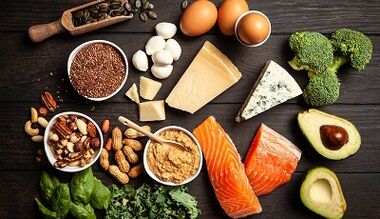
The keto diet is well known as a low-carb diet, where the body produces ketones in the liver to be used as energy.But switching to a low-carb, high-fat diet at the same time can be a challenge.
There's no doubt about it - this is a limited eating plan.In addition to eliminating all refined carbohydrates, you should avoid starchy vegetables, grains, sauces, juices and limit your fruit intake.
Before you start, determine your fitness goal
Before committing to a diet, the first thing to do should always be your "why" or main goal.This will determine your dietary needs and guide you further.There are four main reasons why someone might consider changing their diet, and not all of them are keto-friendly:
Weight loss
Losing weight or fat is the most common reason people decide to try keto.If this is your goal, maintaining a calorie deficit is your main idea.Progress itself can be measured by seeing a number on a scale drop or by changing your body composition, which can be assessed using any body fat analysis tool.
Increased muscle mass
Gaining muscle mass is basically gaining weight, and it's not always ideal for everyone.Also, the ketogenic diet may not be the best diet for building muscle mass, given the beneficial role of carbohydrates in exercise and muscle recovery.But that doesn't stop everyone, and some people see results.To build muscle, focus on extra calories, exercise, and macronutrient balance.And to accurately measure your progress, have a body composition test.
Improved performance
Fat can be an abundant and valuable source of energy that many athletes use.Therefore, the keto diet is suitable for increasing the performance of endurance athletes and those who do not need frequent high-intensity training.Timing of nutrient intake and adequate nutrition is the primary focus of this goal, and progress in performance can be measured by assessing metabolic efficiency.
Improved health

Improved health is not always the primary goal of those following the keto diet, unless health is improved as a result of weight loss.This is because the keto diet is quite restrictive and getting plenty of vitamins and minerals (micronutrients) can be a challenge.
If you want to improve your keto diet, the first thing to think about is your food choices.Progress towards this goal can be measured through biometric testing.However, new research continues to explore the potential benefits of low-carb and keto diets for people with diabetes.
This is how you get into ketosis
Ways to get into ketosis:
- Increased physical activity.
- Significant reduction in carbohydrate intake.
- Check your ketone levels
- Eating protein.
How to switch to the keto diet on your own
Once you've determined your primary health and fitness goal, the next step is to calculate the number of calories you need to eat per day to lose, gain, or maintain your weight.The easiest way to do this is to use an online calorie calculator or download a fitness app that asks your age, height, weight, gender and fitness level to estimate your daily needs.Although calorie control has the biggest impact on your weight, understanding keto macros is still fundamental to continued success.Meeting your daily carb goal is critical, especially if you're trying to achieve ketosis.The keto diet is designed with strict requirements for macronutrients, including high fat intake and extremely low carbohydrate intake.
For most, the requirements look like this:
- 70% calories from fat
- 25% calories from protein
- 5% calories from carbohydrates
However, the exact ideal macronutrient ratio for you may depend on your individual fitness level, metabolic efficiency, and other factors.Now you're ready to start planning the keto menu of your dreams.But before you start eating bacon and cheese, there are a few things to consider.Nutrition and the quality of the foods you eat remain important to your overall health and well-being.Additionally, choosing more nutritious foods can help with energy levels and mood, which in turn will motivate you to stick with the ketogenic diet for longer.Some of the foods should contain healthy carbohydrate substitutes.Products that are good for this include: cauliflower, rice, portobello mushroom dumplings, spaghetti squash.
How to go on a keto diet correctly

Planning your keto menu is only half the battle;your progress is the result of consistency.This means that you need to stick to your diet plan for more than a few weeks.But following a diet is not only based on willpower, but also on developing healthy habits and daily routines that enable you to achieve success.You also don't have to be perfect on the keto diet for it to be effective.It is possible to get off track and still see progress as long as you stay consistent with your calorie goals and continue to work towards them.To follow the keto diet, use the following strategies:
- Read the labels carefully.
Anything that comes in a package, including high-calorie drinks and common medications like cough medicine, can be loaded with hidden carbs.Make sure the label does not contain ingredients such as maltodextrin, dextrose, sugar, cane syrup or starch.Because these substances can increase blood sugar levels and impair the production of ketones.
- Use sweeteners and flour substitutes.
Sugar and flour are difficult to eliminate completely from your diet, but it is possible if you know what to replace them with.Whatever dietary approach you choose, make sure it allows you to maintain your health, well-being and positive results.














































































